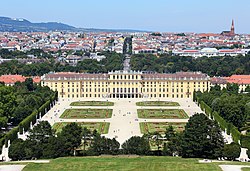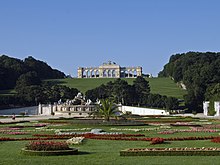Schönbrunn Palace
| Schönbrunn Palace | |
|---|---|
Schloss Schönbrunn | |
 Schönbrunn Palace in 2022 | |
| General information | |
| Location | Hietzing, Vienna, Austria |
| Coordinates | 48°11′04″N 16°18′43″E / 48.184516°N 16.311865°E |
| Website | |
| Official site | |
| Official name | Palace and Gardens of Schönbrunn |
| Criteria | Cultural: i, iv |
| Reference | 786 |
| Inscription | 1996 (20th Session) |
| Area | 160 ha (400 acres) |

Schönbrunn Palace (German: Schloss Schönbrunn [ˈʃlɔs ʃøːnˈbʁʊn] ⓘ; Central Bavarian: Schloss Scheenbrunn) was the main summer residence of the Habsburg rulers, located in Hietzing, Vienna. The name Schönbrunn (meaning "beautiful spring") has its roots in an artesian well from which water was consumed by the court.
The 1,441-room Baroque palace is one of the most important architectural, cultural, and historic monuments in the country. The history of the palace and its vast gardens spans over 300 years, reflecting the changing tastes, interests, and aspirations of successive Habsburg monarchs. It has been a major tourist attraction since the mid-1950s.[1]
History


In 1569,
During the next century, the area was used as a hunting and recreation ground.
After World War II and during the Allied Occupation of Austria (1945—55), Schönbrunn Palace was requisitioned to provide office space for both the British Delegation to the Allied Commission for Austria, and for the headquarters for the small British Military Garrison present in Vienna. With the reestablishment of the Austrian republic in 1955, the palace once again became a museum. It is still sometimes used for important events such as the meeting between U.S. president John F. Kennedy and Soviet premier Nikita Khrushchev in 1961.
Since 1992, the palace and gardens have been owned and administered by the Schloss Schönbrunn Kultur-und Betriebsges.m.b.H., a limited-liability company wholly owned by the Republic of Austria. The company conducts preservation and restoration of all palace properties without state subsidies.
-
Schloss Katterburg and Gonzaga's palace, 1672
-
Johann Bernhard Fischer von Erlach's first design, 1688
-
Fischer von Erlach's second design, after 1693
-
Soviet troops in the Schönbrunn Palace gardens, 1945
-
Schönbrunn during British occupation, 1951
Gardens
The sculpted garden space between the palace and the Neptune Fountain is called the Great Parterre. In 1695, Jean Trehet, a disciple of André Le Nôtre, planned the French garden.
The complex includes many noteworthy staple luxuries of European palaces of the time, including the
The area called Meidlinger Vertiefung (Engl.: depression of Meidling) to the west of the castle was turned into a play area and drill ground for the children of the Habsburgs in the 19th century. At this time it was common to use parks for the military education of young princes.[4] Whereas the miniature bastion, which was built for this purpose, does not exist anymore, the garden pavilion that was used as shelter still does. It was turned into a café in 1927 and is known as Landtmann's Jausen Station since 2013.[5]
At the outmost western edge, a botanical garden going back to an earlier arboretum was re-arranged in 1828, when the Old Palm House was built.
Sculptures
Gloriette
The garden axis points towards a 60-metre-high (200 ft) hill, which since 1775 has been crowned by the Gloriette structure.
Maria Theresa decided the Gloriette should be designed to glorify Habsburg power and the
Roman Ruins
Originally known as the Ruin of Carthage, the Roman Ruin is a set of follies that was designed by the architect Johann Ferdinand Hetzendorf von Hohenberg, and erected as an entirely new architectural feature in 1778.
The fashion for picturesque ruins that became widespread with the rise of the Romantic movement soon after the middle of the 18th century symbolized both the decline of once great powers and the preservation of the remains of a heroic past. The Roman Ruin consists of a rectangular pool enclosed by a massive arch with lateral walls, evoking the impression of an ancient edifice slowly crumbling into the ground.
Activities at Schönbrunn today
Schönbrunn is Vienna's most popular tourist destination, which has been attended by 3,800,000 visitors in 2017.
The annual Summer Night Concert Schönbrunn is held on the grounds of Schönbrunn.[8]
Schönbrunn Palace Concerts
The Schönbrunn Palace Concerts are served by the Schönbrunn Palace Orchestra. Founded in 1997, it is led by the chief opera conductor Maestro Guido Mancusi since 1998. He also founded Chamber Opera Schönbrunn in the Schönbrunn Palace Concert series.
In Vienna, they offer daily concerts at the original location of the world-famous contest between Mozart & Salieri (1786). They have a wealth of experience working with singers and ballet dancers. The Orchestra regularly tours around the world.
Film and television productions
This section needs additional citations for verification. (April 2022) |
The gardens and palace have been the location for many films and television productions including such productions as the
The Austrian television series,
In the third leg of The Amazing Race 4, the palace hosted a Fast Forward task where one team had to carry trays of champagne glasses across a ballroom floor of waltzing couples.[10] In the sixth leg of The Amazing Race 23, teams had to race through the garden's maze and search for the Pit Stop located at the Gloriette.[11]
The
which first aired in January 2007.Gallery
-
A garden pavilion, Kammergarten pavilion
-
Cafe Gloriette Schönbrunn
-
The Roman Ruin.
-
View from Great Parterre towards the Gloriette
(app. towards South). -
View of the gardens
-
View of the gardens in autumn
-
Orangery, in NE part of the gardens.
-
Columbary
-
Palm pavilion in western part of the gardens
-
The Palm House
-
Sundial House
-
Privy garden in winter
-
Schönbrunn seen through Neptune Fountain
-
Schönbrunn
The Schönbrunn Palace silver coin
The palace was selected as the main motif of a high value commemorative coin: the Austrian 10-euro The Palace of Schönbrunn silver coin, minted on 8 October 2003. The obverse shows the central part of the frontage of the palace behind one of the great fountains in the open space.
See also
- Imperial Carriage Museum
- Chinese Cabinets in Schönbrunn Palace
- Tiergarten Schönbrunn, the zoo in the palace gardens that claims to be the oldest one in the world
- Gloriette
- List of Baroque residences
- List of World Heritage Sites in Austria
References
- ^ Official website
- ^ "The Park under Maria Theresa". Schloß Schönbrunn. Schloß Schönbrunn. Retrieved 3 November 2014.
- ^ "Who owns the palace?". Schloß Schönbrunn. Schloß Schönbrunn. Retrieved 3 November 2014.
- ^ "Meidlinger Vertiefung" (in German). Archäologischer Dienst GesmbH. Retrieved 28 November 2014.
- ^ "The history of the Landtmann Jausen Station". Retrieved 28 November 2014.
- ^ "Wien Besucherzahlen" [Vienna Visitor Statistics] (in German). Retrieved 25 March 2018.
- ^ Schönbrunn ist Wiens beliebteste Sehenswürdigkeit (in German). Die Presse, 4 August 2010. Retrieved 15 August 2010.
- ^ "The Arts - Rolex Timeless Luxury Watches". Rolex. Rolex. Retrieved 9 August 2017.
- ^ "Schönbrunn Palace | James Bond Locations".
- ^ "ARCHIVES: The Amazing Race 4". Game Show Newsnet. Retrieved 1 January 2020.
- ^ Barrett, Annie (4 November 2013). "The Amazing Race recap: 'Choir Boy at Heart'". Entertainment Weekly. Retrieved 1 January 2020.
External links
This article's use of external links may not follow Wikipedia's policies or guidelines. (April 2022) |
- Official Schönbrunn website (in English)
- Information about Schönbrunn (in English)
- Everycastle.com: Schönbrunn History and Pictures
- Schönbrunn Gigapixel Panorama (12,000 Megapixel)
- Wien.info: Schönbrunn Palace—”Empress Sisi's former summer residence”
- Schönbrunn Palace: My Way of Telling History (PDF format)
- Official Vienna city map: Schönbrunn—a far better aerial view, zoomable up to <1m resolution.
*Click "Orthophoto" and "Draw new map", then zoom in [there seems to be no direct link]. - Video of a street walk through the Schönbrunn Palace Gardens
- Video about the Japanese Garden in the park of Schoenbrunn Palace (in English)
- Hassmann, Elisabeth (2004). Von Katterburg zu Schönbrunn. Wien: Böhlau. ISBN 978-3-205-77215-6.
- Pfeifer, N.; Rottensteiner, G. (2001). The Riegl laser scanner for the survey of the interiors of Schönbrunn Palace (PDF). Fifth Conference on Optical. pp. 571–8.






























